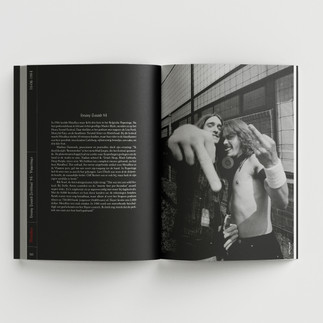Amplifiers turned to ten
- david1170
- Oct 4
- 4 min read
‘Heavy Sounds In The West’ by Hans Verbeke and Onno Hesselink reviewed by Djordje Miladinovic of Thoughts Words Action...
Heavy Sounds in the West is one of those rare instances where music history insists on dragging a place into its rightful spotlight.
With a detailed, almost obsessive devotion to detail, Hans Verbeke and Onno Hesselink have constructed a monumental document of how heavy metal and crossover hardcore culture detonated in the unlikely soil of West Flanders. Their tremendous effort resulted in a coffee-table behemoth, comprising over 400 pages of full-colour ephemera, photographs, posters, and battered memories, a vital reclamation of cultural history, refusing to let the margins stay marginal.
West Flanders, long imagined as a sleepy, provincial corner of Belgium, erupts in these pages for more than a good reason. The book makes clear that what happened there between the late seventies and early nineties was not peripheral, not secondary, but an essential node in the web of heavy music’s global spread. Metallica, Slayer, Motörhead, Venom, Kreator, Rush, Mercyful Fate, and many more important names roll through these pages. However, what matters here is not just that these titans passed through, but how West Flanders, with its makeshift venues and stubborn promoters, offered them a stage at all. Promoters recalling the chaos of booking bands that no one yet believed in. Fans remembering the first time a Marshall stack rattled their ribs. Musicians, half-drunk, telling the truth in all its unruly, unpolished sincerity. These testimonies, presented without cosmetic smoothing, form a lively, imperfect, and therefore deeply convincing story. It’s oral history at its rawest, and that makes this book so good.
Verbeke and Hesselink understand the allure of memorabilia. Flyers plastered across these pages, some scrawled by hand, others cheap offset jobs, tell stories no prose could fully capture. A snapshot of Slayer grinning like teenagers before they were legends, a scuffed ticket stub from a long-defunct venue, beer-stained setlists carried home as trophies, these relics do not just illustrate the past. They are the past, brought back to the surface like archaeological fragments. The book situates heavy music as a cultural eruption and social necessity.
West Flanders, so often portrayed as staid, conservative, even inert, finds itself shaken awake by distortion, speed, and fury. The book argues, persuasively, that this awakening was not accidental. Economic stagnation, generational boredom, and political unrest created a hunger that only the radical energy of metal and crossover hardcore could satisfy. If you want to know why metalheads would travel hours across muddy roads for a gig in a barn, this book supplies the context, because those nights felt like oxygen in a suffocating world. Heavy Sounds in the West doesn’t romanticize the past. There is reverence for the giants who played, but there is also a courageous acknowledgment of chaos, failure, and absurdity. Shows collapsed, gear broke, bands fought, audiences rioted, and still, out of the mess, something unrepeatable happened. By not sanding down the rough edges, Verbeke and Hesselink preserve the truth of the underground that it was never meant to be tidy.
Many of these voices come decades after the fact. Stories conflict, and dates blur. Did Venom really play that badly? Was the hall truly packed when Motorhead came through, or is nostalgia inflating the numbers? The authors wisely avoid adjudicating. Instead, they present the contradictions side by side, trusting the reader to grasp that the unreliability of memory is part of what gives this history its texture. The scope is staggering. Over three hundred photos, many never before published, provide an almost cinematic immersion. The density of this visual archive means the book can be approached as a chronology and a gallery. One can flip through randomly and still materialize with a visceral sense of time and place. West Flanders becomes a microcosm of how youth cultures germinate in unlikely soil, how global movements find local footholds. Heavy music belongs not just to New York, London, or Los Angeles, but to the provincial towns where scenesters scraped together enough to rent a hall and put on a show. The writing is sharp, unsentimental, and never lapses into academic jargon. Verbeke and Hesselink know their subject too intimately for distance. They do not disguise their affection, but their affection is tempered by honesty. They are as willing to recount embarrassing failures as transcendent triumphs. This openness gives the book its credibility. Heavy Sounds in the Westreminds that cultural revolutions are not always glamorous. They are often awkward, cobbled together, and precarious. Yet out of such precariousness, something eternal emerges for generations to come.
It is tempting to call Heavy Sounds in the West a coffee-table book, but that would diminish it. It’s closer to an atlas, a cartography of noise, sweat, and defiance, mapping how a slumbering province awoke under the pressure of amplifiers turned to ten. Verbeke and Hesselink preserved a vivid memory of their local scene and constructed a monument. It’s like all good monuments, it doesn’t just commemorate the past but it also confronts it, demanding we recognize its power, its unruliness, and its ongoing relevance.














Comments